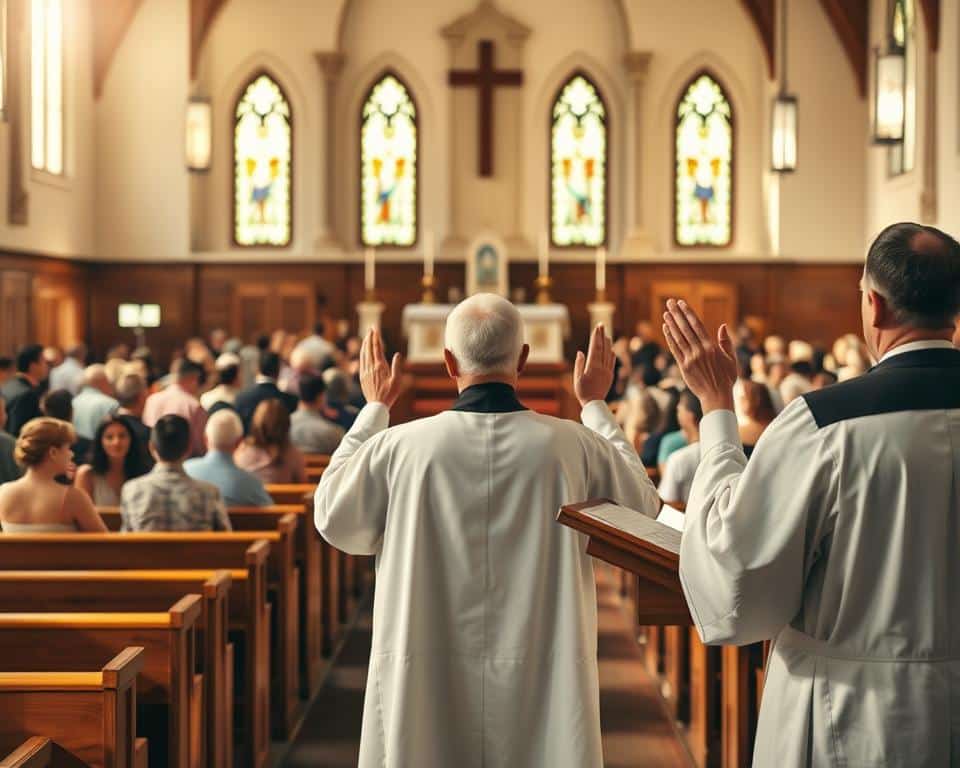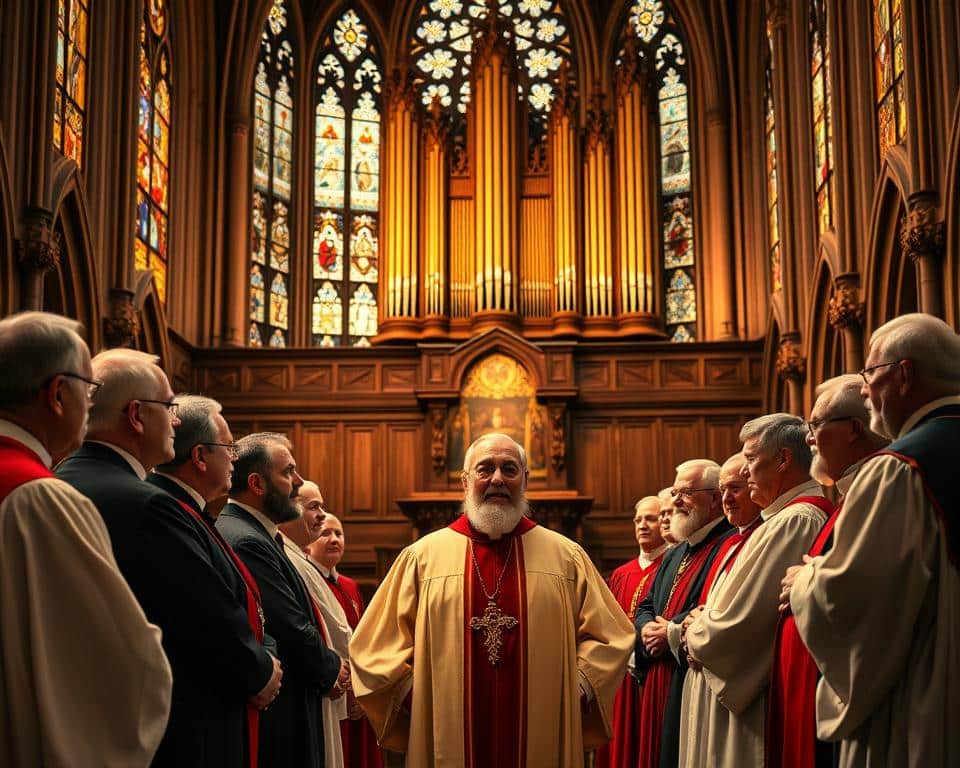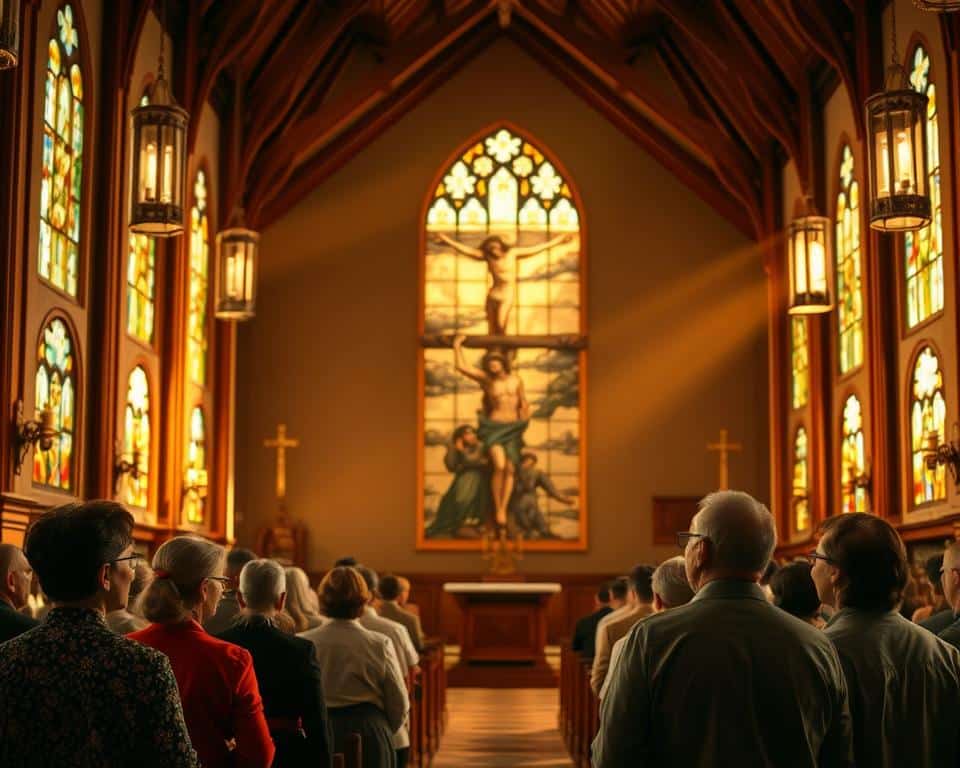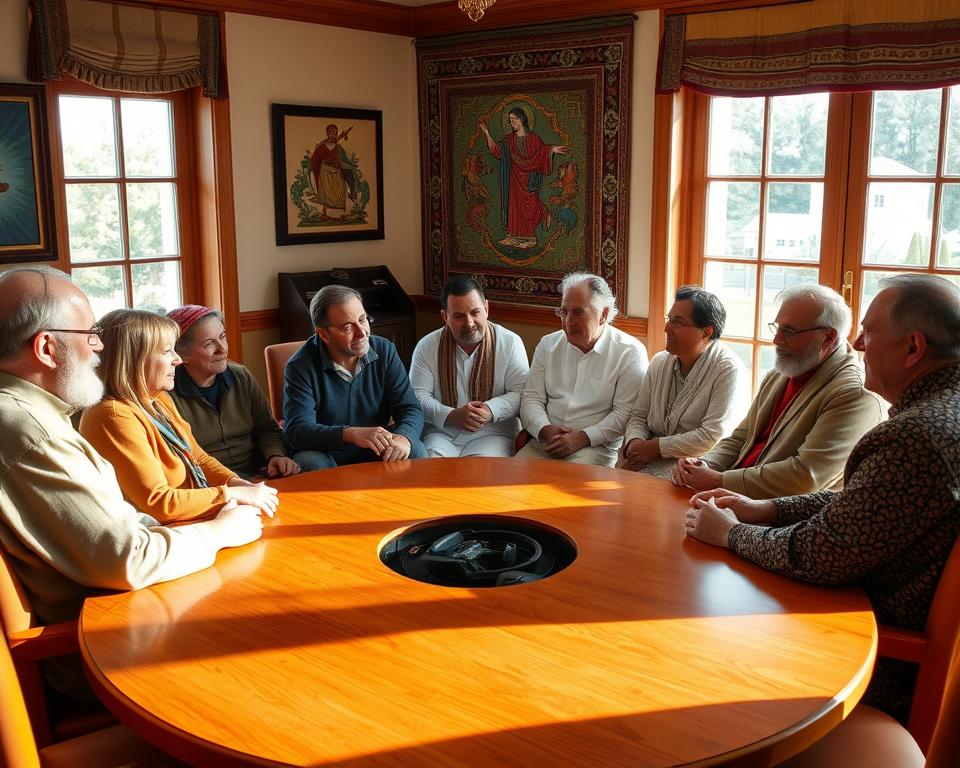Have you ever wondered how a faith community thrives? Strong church leadership is the backbone of every growing congregation. It ensures truth, hope, and order align with God’s word.
Scripture provides clear guidance, like in 1 Timothy 3:1-13, outlining qualities for those who serve. Leaders—pastors, teachers, and servants—work together to guide members toward deeper faith.
This article explores how structured positions strengthen the body of believers. You’ll learn how each role supports worship, teaching, and outreach. Let’s dive into the foundation of effective ministry.
1. The Importance of Church Leadership Roles
A thriving faith community relies on clear direction and shared purpose. When teams serve with defined responsibilities, congregations grow stronger. Scripture provides timeless models for this, blending truth with practical care.

How Leadership Fosters Community Growth
Acts 6:1-7 shows the early church appointing deacons to manage daily needs. This freed apostles to focus on teaching and prayer. Structured service prevented burnout and kept outreach efforts alive.
Today, the same principle applies. When pastors and teams share duties, ministries flourish. Member retention rises when everyone feels supported.
“Shepherd God’s flock among you, not overseeing out of obligation but willingly, as God would have you.”
Biblical Foundations for Church Structure
Paul’s letters to Timothy and Titus outline elder qualifications: integrity, wisdom, and a heart for teaching. Titus 1:5-9 emphasizes character over charisma. These standards ensure doctrinal consistency.
Elders and deacons work together—one guiding spiritually, the other serving practically. This balance helps churches care for internal needs while reaching outward.
Like a body with many parts, each role matters. When all serve where gifted, the whole congregation thrives.
2. Key Pastoral Roles in Church Leadership
Behind every vibrant ministry is a team of pastors fulfilling unique callings. Each position blends teaching, service, and administration to support the congregation. Let’s explore three vital roles.

Senior Pastor: Spiritual and Administrative Head
The senior pastor acts as both shepherd and strategist. They deliver sermons while overseeing staff and long-term vision. Like a CEO, they balance preaching with operational decisions.
Their responsibilities include mentoring other pastors and ensuring doctrinal alignment. A strong leader fosters unity, helping the congregation grow in faith and outreach.
Associate Pastor: Supporting Pastoral Duties
Associate pastors often handle specialized tasks. They may conduct weddings, visit homebound members, or lead small groups. Many are ordained, requiring theological training and mentorship.
These pastors step in when the senior pastor is unavailable. Their flexibility keeps ministries running smoothly during transitions or crises.
Youth Pastor: Guiding Younger Congregations
Youth pastors connect with teens through relatable teaching and events. They use social media, mission trips, and interactive programs to engage Gen Z.
Some churches build multi-campus youth facilities for larger outreach. This role demands creativity and a deep understanding of young believers’ needs.
Together, these pastors form a team that balances preaching, care, and administration. Their shared efforts create a thriving faith community.
3. Essential Support Leadership Positions
Every thriving congregation depends on dedicated teams working behind the scenes. These roles ensure smooth operations, freeing pastors to focus on teaching and prayer. Let’s explore three key positions.
Minister of Finance: Managing Resources
The finance minister handles offerings and budget oversight. They work with CPAs to ensure transparency and compliance. Trustworthy stewardship protects the church’s mission and honors God’s word.
Weekly tasks include counting donations and tracking expenses. Annual budgets align with outreach goals and facility needs. This role safeguards resources for future growth.
Minister of Music: Overseeing Worship Arts
Music ministers direct choirs—youth, men’s, women’s, and mass ensembles. They secure copyrights for performances and select hymns that deepen faith. Worship music unites the congregation in praise.
From rehearsals to live streams, they blend tradition with innovation. Their work transforms Sunday services into uplifting experiences.
Director of Outreach: Connecting with the Community
Outreach leaders organize food drives, addiction support, and school supply initiatives. They partner with local prisons for re-entry programs. Practical service reflects Christ’s love beyond church walls.
Volunteers are trained to mentor and meet urgent needs. These efforts build bridges and foster lasting relationships.
“Let your light shine before others, so they may see your good works and glorify your Father in heaven.”
Together, these roles strengthen both the congregation and the broader community. They turn vision into action, one detail at a time.
4. Roles in Church Governance
Biblical governance balances spiritual wisdom with everyday service. When teams align with God’s word, they foster unity and clarity. This structure ensures truth guides decisions while practical needs are met.
Elders: Guardians of Faith and Truth
Elders focus on doctrine and pastoral care. Titus 1:6-9 outlines their qualifications: being “above reproach,” self-controlled, and skilled in teaching. They shepherd the congregation through prayer and Scriptural guidance.
In the Presbyterian model, elders form councils to make faith-based decisions. This prevents one person from holding unchecked influence. Shared oversight reflects Christ’s humility.
Deacons: Hands-On Servants
Deacons handle logistics like facility upkeep and communion preparation. Acts 6:1-7 shows their role in freeing apostles for teaching. Today, they ensure smooth operations so others can focus on ministry.
- Elders lead spiritually; deacons serve practically.
- Both require integrity but differ in focus.
Church Boards: Strategic Stewards
Boards provide direction through three key tasks:
- Budget approval—allocating funds for outreach and needs.
- Policy creation—setting guidelines for staff and members.
- Staff oversight—supporting pastors and volunteers.
“An elder must be blameless, faithful to his wife, a man whose children believe and are not open to the charge of wild living.”
Together, these groups create checks and balances. Elders safeguard truth, deacons manage service, and boards plan for growth. This triad keeps the church anchored in God’s purpose.
5. Specialized Ministry Leadership Roles
Modern ministries thrive when specialized teams step forward to meet unique needs. These leaders blend faith with practical skills, ensuring congregations stay safe, connected, and mission-focused.
Director of Evangelism: Spreading Faith Initiatives
Evangelism directors organize door-to-door outreach and tract distributions. They train volunteers to share hope in neighborhoods and online. Many use tools like Bible study apps to deepen conversations.
Their work aligns with Matthew 28:19—making disciples everywhere. From park gatherings to prison ministries, they turn faith into action.
Director of Security: Ensuring Safety During Services
Security teams coordinate with off-duty police to protect worship spaces. Common protocols include:
- Armed guards monitoring entrances
- Secure offering collection processes
- Discreet protection for pastors during events
These measures let members focus on worship without fear.
Director of Media: Managing Communications
Media teams handle live streams, social media, and copyright compliance for music. During COVID-19, they shifted services online, reaching isolated believers.
Tools like ProPresenter and CCLI licenses ensure legal streaming. Their work bridges gaps between the pulpit and the pew—and beyond.
“How beautiful are the feet of those who bring good news!”
Together, these roles adapt ministries to modern challenges. They prove that every gift—whether teaching, protecting, or broadcasting—can glorify God.
6. Models of Church Leadership Structures
Different churches follow distinct governance models shaped by history and Scripture. You’ll notice some prioritize bishops, while others let congregations vote. Each approach reflects a balance of faith and practical direction.
Episcopal Model: Hierarchy with Bishops
Episcopal churches, like Catholics and Methodists, use a top-down structure. Bishops oversee pastors and make doctrinal decisions. This system ensures unity across 400,000+ U.S. members.
Key traits:
- Centralized authority prevents doctrinal drift.
- Historical roots trace to early apostles.
Congregational Model: Member-Driven Decisions
Baptists and non-denominational groups often vote on pastors and budgets. Acts 15 shows early believers resolving disputes collectively. This model empowers local churches but risks slow decision-making.
Contrasts with Episcopal:
- No bishops; pastors answer to members.
- Flexible but less doctrinal consistency.
Presbyterian Model: Elder-Led Governance
Presbyterians appoint elders to blend teaching with oversight. Titus 1:5-9 guides their qualifications. Councils of elders share leadership, avoiding single-point failures.
How it works:
- Elders teach and disciple.
- Deacons handle logistics.
- Congregations affirm major changes.
“Obey your leaders and submit to them, for they keep watch over your souls.”
Martin Luther’s Reformation sparked debates over these models. Today, your denomination’s choice reflects its view of Scripture’s direction. Whether hierarchical or democratic, the goal remains the same: serving God’s people well.
7. Qualifications for Church Leadership Roles
God sets clear standards for those who guide His people. Whether serving as elders, deacons, or administrators, leaders must align with Scriptural benchmarks. These requirements protect the congregation and honor God’s calling.
Biblical Requirements for Elders and Deacons
Titus 1:6-9 lists five non-negotiable traits for elders:
- Above reproach: A blameless reputation.
- Faithful in marriage: A stable home life (1 Timothy 3:4).
- Self-controlled: Wise decision-making.
- Hospitable: A heart for service.
- Able to teach: Grounded in God’s word.
Deacons share similar character standards but focus on practical service (Acts 6:3). Both roles require humility and a proven track record.
Practical Skills for Administrative Roles
Beyond biblical traits, some positions demand specialized expertise. For example:
- Finance ministers often need CPA certification to manage budgets.
- Youth leaders undergo background checks for child safety.
- Board members train in conflict resolution to navigate disputes.
“An overseer must be above reproach, entrusted with God’s work.”
Training and Ordination Processes
Paths to leadership vary:
- Seminary training: Pastors often complete theology degrees.
- On-the-job mentoring: Deacons may apprentice under experienced leaders.
- Ordination: Required for preaching roles, not all administrative ones.
Churches increasingly combine formal education with hands-on experience. This ensures leaders are both doctrinally sound and practically equipped.
8. How Leadership Roles Impact Church Growth
Healthy churches don’t grow by accident—they’re built through intentional leadership. When teams serve with clarity, congregations flourish. Research shows churches with executive ministers retain 22% more members.
Case Studies: Structures That Work
Megachurches like North Point Community Church thrive by specializing staff. Their model includes:
- Dedicated youth pastors boosting family attendance by 40%.
- Outreach teams increasing community visibility through food drives.
- Clear role definitions, as seen in Baptist expansions.
Stagnant churches often lack this focus. They may have gifted pastors but unclear support structures. The difference? One plans; the other reacts.
Balancing Faith and Operations
Great leaders merge Sunday sermons with Monday logistics. For example:
- Pastors preach hope while deacons manage facilities.
- Boards allocate funds for missions and maintenance.
“Where there is no vision, the people perish.”
With 27% of Americans attending weekly services, churches that prioritize both truth and teamwork grow. Your congregation can too.
9. Building a Strong Leadership Team for Your Church
Strong teams build lasting faith communities through shared vision. Start by assessing needs—identify gaps in teaching, outreach, or administration. Use surveys or spiritual gift inventories to match volunteers with roles.
Recruit talent intentionally. Look for humble servants grounded in Scripture. Train them with SMART goals—specific, measurable skills like budgeting or conflict resolution.
Establish accountability. Review progress annually and adjust roles as your congregation grows. Tools like Donorbox streamline fundraising for training or outreach.
Plan for transitions. Mentor future pastors and document processes. When changes arise, involve the congregation through prayerful votes.
With God’s direction, your team will thrive. Equip them well, and watch faith multiply.





